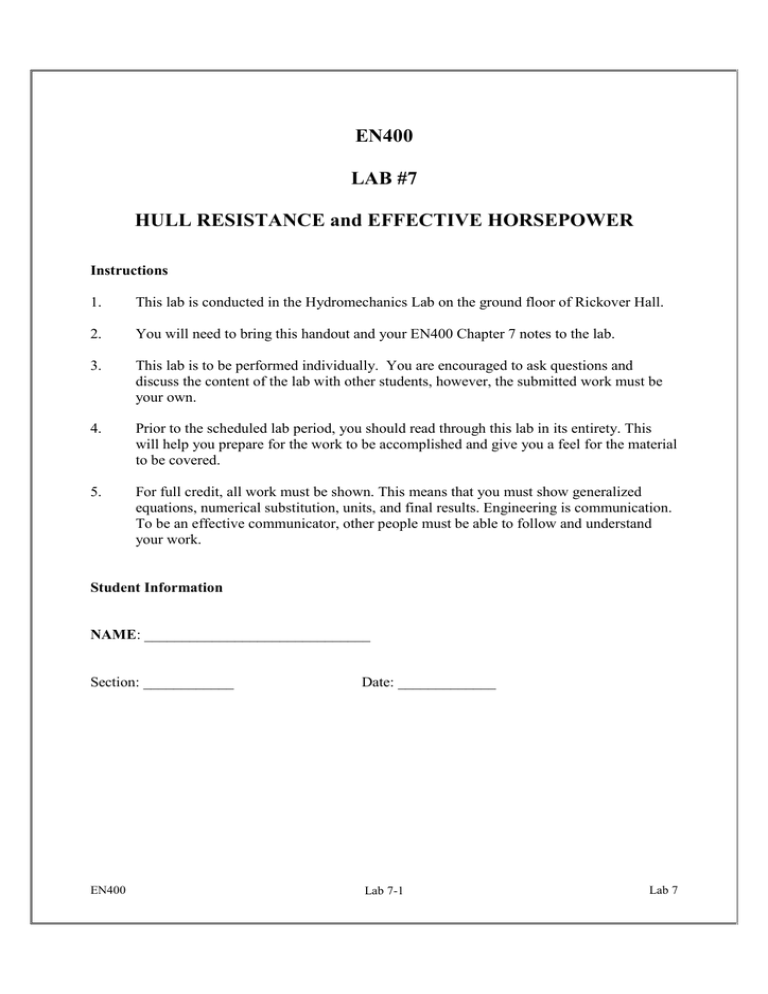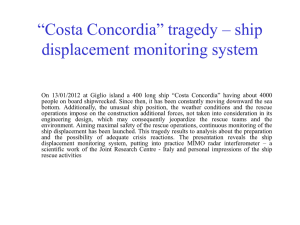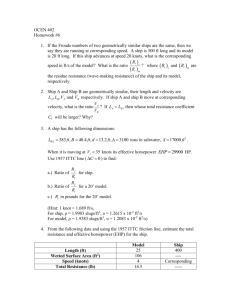EN400 LAB #7 HULL RESISTANCE and EFFECTIVE HORSEPOWER
advertisement

EN400 LAB #7 HULL RESISTANCE and EFFECTIVE HORSEPOWER Instructions 1. This lab is conducted in the Hydromechanics Lab on the ground floor of Rickover Hall. 2. You will need to bring this handout and your EN400 Chapter 7 notes to the lab. 3. This lab is to be performed individually. You are encouraged to ask questions and discuss the content of the lab with other students, however, the submitted work must be your own. 4. Prior to the scheduled lab period, you should read through this lab in its entirety. This will help you prepare for the work to be accomplished and give you a feel for the material to be covered. 5. For full credit, all work must be shown. This means that you must show generalized equations, numerical substitution, units, and final results. Engineering is communication. To be an effective communicator, other people must be able to follow and understand your work. Student Information NAME: ______________________________ Section: ____________ Date: _____________ EN400 Lab 7-1 Lab 7 Apparatus 1. The following model and ship data for the USNA YP is provided: Model Data Full-Scale YP Data Length between perpendiculars (LM) = 5 ft Length between perpendiculars (LS) = 101.65 ft Fresh water at 65°F Salt water at 59°F Background 1. Ship resistance is a function of many factors. Some factors affecting resistance include ship speed, hull form and size, displacement, hull fouling, water temperature, waves, current, and wind. 2. In the design of a ship, many towing tank tests of a model geometrically similar to the full-scale ship are performed to determine the ship’s horsepower requirements and performance characteristics. Tests are done on several hull designs in order to select the “best” hull to be constructed. A carefully planned and executed series of model tests, although somewhat expensive, is extremely beneficial and cost efficient in selecting the final design of a ship’s hull. Data collected on a model can be scaled up to predict the full-scale ship’s performance. 3. Instead of testing a potential design for a ship, this lab will use an established hull design, the USNA YP, and will concentrate on the effect of an increase in ship displacement on the power required to propel the ship through the water. 4. Throughout the life of a ship its displacement will change, whether through fuel and water consumption, or because of equipment additions. History has shown that a ship’s displacement (especially warships) will increase 10-15% over the life of a ship. For instance, the FFG-7 class was initially designed for a displacement of 3,700 LT. The class now has an operational displacement of approximately 4,100 LT, an increase of 10%. Components of Hull Resistance 1. In the laboratory, the two most important components of hull resistance are viscous and wave making resistance. Mathematically, this is written as: RT RV RW where: EN400 RT = total hull resistance RV = viscous resistance RW = wave making resistance Lab 7-2 Lab 7 3. Figure 1 below is a graph showing the components of resistance for a YP hull. Note how the wave making component of resistance increases as speed increases. At speeds of 4, 8, and 14 knots, what percentage of the total resistance can be attributed to wave making? 4 knots: _______ 4. 8 knots: _______ 14 knots: ________ The graph of total hull resistance shows a slight “hump” at a speed of 6 knots. What factor has caused this hump to occur? _____________________________________________________________________ _____________________________________________________________________ Figure 1: Components of YP total hull resistance Calculating Resistance for S = 172 LT 1. EN400 The model will now be towed in the tank at scale speeds corresponding to full-scale ship speeds (VS) of 4, 7, 12, and 14 knots. Lab 7-3 Lab 7 a. As the model is being towed, carefully observe the wave pattern (transverse and divergent waves) created by the model as it moves down the tank. Sketch the transverse and divergent wave patterns for speeds of 4 and 14 knots on the diagrams in Figure 2. Figure 2: Diagram of YP wake patterns at speeds of 4 and 14 knots. b. A very good approximation of the total hull resistance for a ship is to multiply the total hull resistance of the model by the cube of the scale factor. Using the experimental data and this relationship complete Table 2. RTS RTM 3 VS (kt) 4 7 12 14 Table 2: YP Resistance and EHP Data at S = 172 LT VS (ft/s) VM (ft/s) RTM (lb) RTS (lb) EHP (HP) c. Show your understanding of these calculations by showing your work for a ship speed of 12 knots in the space below. d. Why is the model being towed at speeds using the above equation (Froude’s Law of Corresponding Speeds)? _______________________________________________________________________ EN400 Lab 7-4 Lab 7 _______________________________________________________________________ e. Why does the model have a row of studs running vertically near its bow? _______________________________________________________________________ f. When conducting model tests, is it better to use a larger or smaller model? Why? _______________________________________________________________________ Resistance Data for S = 139 LT 1. Table 3 below contains bare hull EHP data for a YP at a displacement of 139LT. Table 3: YP EHP Data at S=139 LT Ship Speed, VS (kts) Effective Horsepower, EHP (HP) 2 2 4 8 6 28 8 62 10 142 12 272 14 512 2. Plot your EHP results for 172LT and 139LT displacements using Excel. a. What happened to the effective horsepower of the YP after increasing its displacement to 172 LT? Why? __________________________________________________________________ __________________________________________________________________ b. How does increasing speed affect the effective horsepower at a displacement of 172 LT? Specifically, what has happened to the horsepower requirement as speed increased from 4 to 7 knots, and from 12 to 14 knots? __________________________________________________________________ __________________________________________________________________ c. The YP’s were designed to have a maximum speed of 13.25 knots. Based on your data, explain why this value may have been chosen. __________________________________________________________________ __________________________________________________________________ EN400 Lab 7-5 Lab 7 d. How would operating in shallow water affect the YP’s effective horsepower? _______________________________________________________________ Added Resistance and Ship Hull Response in Regular Waves 1. To demonstrate how ocean waves affect resistance over and above calm water resistance, the model will now be towed at a constant speed corresponding to a full-scale speed of 12 knots in three different regular wave patterns. The three regular wave patterns will have the following characteristics: 1) wave length four times the model’s length, 2) wave length equal to the model’s length, and 3) wave length one half the length of the model. Full-scale wave height is approximately 4.2 ft (sea state 3). 2. During these runs, carefully observe the motion of the model, especially in pitch and heave. You will see a different response in each wave pattern. Record the dominant motion (pitch or heave) observed during each run below in the Table 3. Table 3: YP Motion in Regular Waves Wave Pattern VS Dominant Response (kt) Motion Lwave = 2*LM 12 Lwave = LM 12 Lwave = ½LM 12 3. Which regular ocean wave pattern produced the largest amount of pitching motion? _______________________________________________________________________ 4. Which regular ocean wave pattern produced the largest amount of heave motion? _______________________________________________________________________ 5. Based on your observations of ship motion in the lab, list and describe 3 additional factors, in addition to wavelength, that would affect the motion of a ship in waves. a. b. c. Shaft Horsepower and Fuel Consumption 1. EN400 Once a ship’s effective horsepower has been determined through model testing, the shaft horsepower required to drive the ship must be determined, since it is shaft horsepower that is purchased. Lab 7-6 Lab 7 2. What element in the drive train causes the biggest propulsive losses? ________________ 3. YP’s are equipped with two propeller shafts with one 437 HP diesel engine driving each shaft. Why would two engines be used instead of a single 875 HP engine driving a single propeller shaft? ________________________________________________________________________ ________________________________________________________________________ Shown below is a plot representing the SHP and fuel consumption of a single propulsion engine. Use this plot to answer the remaining questions in this lab. Figure 3: Shaft horsepower and fuel consumption data for a single YP diesel engine 4. From the experimental EHP data and assuming a propulsive coefficient of 55%, determine the total SHP required to travel in calm water at 10 and 12 knots for both displacements. Then use the graph to complete Table 5 below. Table 5: YP Fuel Consumption Table (LT) VS (kt) 139 139 10 12 172 10 EN400 Total EHP (from plot) Total SHP SHP per Engine Lab 7-7 Fuel Consumption Rate per Engine (gal/hr) Total Fuel Consumption Rate (gal/hr) Lab 7 172 5. 12 How has the increase in displacement affected the amount of fuel burned by the YP? _______________________________________________________________________ _______________________________________________________________________ 6. Shown below is a table of engine rpm and a corresponding ship speed. Using this table and the fuel consumption chart, answer the following question. It is desired to travel a distance of 1800 nautical miles and arrive with 50% of 6800 gallons of fuel onboard. Using two engines, at what speed must the YP travel in order to meet this requirement? YP Engine RPM Table (2 engines) Engine rpm Speed (kts) 500 4 825 6 970 7 1125 8 1290 9 1460 10 1650 11 1850 12 2060 13 2100 13.25 EN400 Lab 7-8 Lab 7






